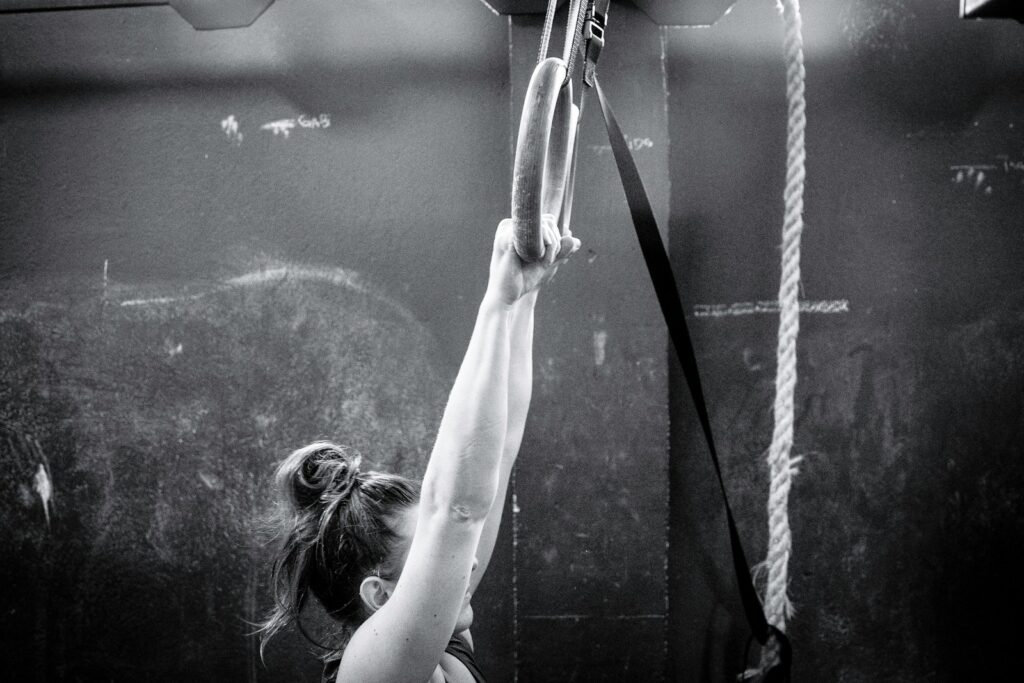Introduction
The ring muscle-up is a highly challenging yet popular movement in CrossFit and gymnastics. It tests your upper body strength and fluidity of motion. Despite its appeal, the ring muscle-up is far more complex than it seems, requiring excellent body balance and proper form. Many people struggle to perform it efficiently.
A foundational exercise that can significantly aid in mastering the ring muscle-up is the ring dead hang. In this article, we’ll explore why ring dead hang is so effective for muscle-up progression, its benefits, correct technique, and tips for building strength through this exercise.

1. What Is a Ring Dead Hang?
The ring dead hang is a movement where you suspend your body on gymnastic rings in a static position. Essentially, it involves gripping the rings with both hands and letting your feet lift off the ground, maintaining a stable position. The key is to engage and stabilize muscles in the shoulders, arms, and core.
Although simple, holding this position for extended periods develops multiple skills crucial for executing a ring muscle-up, as described below.
2. Benefits of the Ring Dead Hang
2.1 Enhances Shoulder and Scapular Stability
Performing the ring dead hang strengthens the muscles around the shoulders and scapula, especially the trapezius and rhomboids. Without shoulder stability, you may struggle with pulling movements or kipping during a muscle-up, and risk injuring your shoulders. The ring dead hang improves these muscles, ensuring proper stability during motion.
2.2 Strengthens Grip and Forearm Muscles
Hanging from the rings actively engages your grip and forearm muscles. Without a strong grip, the entire muscle-up movement can become unstable, leading to form breakdown. Consistent practice of the ring dead hang improves grip strength, reducing the risk of slipping during the muscle-up. Additionally, it effectively transmits pulling power. Compared to bar dead hangs, it also minimizes hand discomfort or calluses.
2.3 Improves Core Stability
The ring dead hang not only works the arms and shoulders but also engages the core. Keeping your body steady requires the use of abdominal and back muscles, which enhances core stability. A stable core is crucial in the muscle-up to reduce forward and backward sway, and practicing the ring dead hang helps build the required control.
2.4 Promotes Proper Posture and Body Awareness
Hanging on the rings helps you become more aware of your posture and movement. It requires you to avoid letting your shoulders rise too close to your ears or letting your back round excessively. This heightened body awareness translates to maintaining proper form during a muscle-up.
3. How to Perform a Ring Dead Hang
Here’s how to safely practice the ring dead hang:
- Adjust the ring height: Set the rings high enough so your feet won’t touch the ground.
- Grip the rings: Firmly hold the rings with your palms, ensuring your knuckles point upward. Also, rope climbing is really effective for grip strength. Detail is here.
- Engage your shoulders: Avoid shrugging your shoulders. Instead, pull your shoulder blades slightly downward and inward for stability.
- Stabilize your body: Engage your core muscles and maintain a steady, motionless hanging position.
Start with 10-second holds and gradually extend to 30 seconds or 1 minute as you build endurance.

4. How Ring Dead Hang Improves Your Muscle-Up
4.1 Enhances Pull-Up Strength
The ring dead hang strengthens the muscles used during pull-ups, making it easier to execute the upward pull phase of the muscle-up. Improved pulling strength allows you to smoothly transition your torso above the rings.
4.2 Supports Kipping Movements
Kipping is a key swinging motion in a muscle-up. The ring dead hang strengthens the core and shoulders, providing the control needed for efficient kipping. Improved kip control boosts overall movement efficiency and fluidity.
4.3 Increases Stability During Transitions
The transition phase—from pulling to dipping—is one of the most challenging parts of a muscle-up. Without stability, your power may dissipate during this phase. The shoulder and core stability gained from the ring dead hang helps make transitions smoother and more controlled.
5. Tips for Effective Ring Dead Hang Practice
5.1 Adjust Frequency and Duration
Incorporate ring dead hangs into your weekly training routine. Start with short durations and gradually increase as you build endurance. Avoid overstraining your shoulders or forearms, and rest if you feel fatigued.
5.2 Focus on Proper Form
While performing the ring dead hang, keep your shoulders down and engage your scapulae. Avoid letting your form deteriorate, as it diminishes the exercise’s effectiveness. Pay attention to maintaining a neutral spine without excessive arching.
5.3 Combine with Other Exercises
Pair the ring dead hang with other movements like pull-ups, dips, and core exercises. This enhances overall strength and stability, which are essential for a successful muscle-up. Core-focused exercises are particularly useful for improving body control.

Conclusion
The ring muscle-up is a goal for many CrossFit and gymnastics enthusiasts, but mastering it takes time and effort. The ring dead hang serves as a foundational step, building the strength and stability needed to perform smooth muscle-up movements.
By incorporating the ring dead hang into your training routine, you can strengthen your shoulders, core, and grip, enabling pain-free and confident progress toward your muscle-up goals. Start practicing today, and take one step closer to achieving this challenging movement.
Sho
Read more
Pain-Free Tips for Mastering the Butterfly Chest-to-Bar in CrossFit
Pain-Free Tips for Mastering the Butterfly Chest-to-Bar in CrossFit
